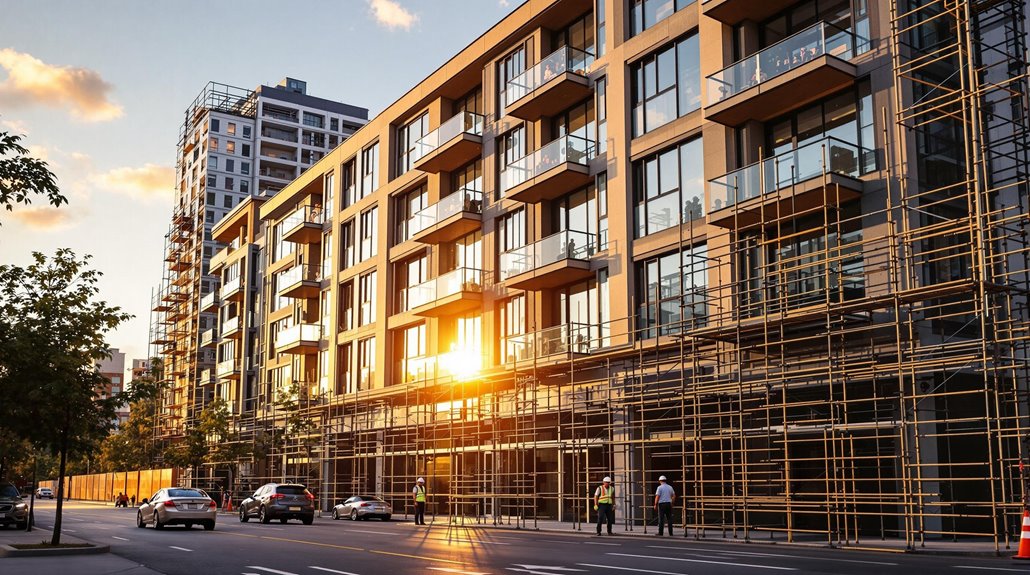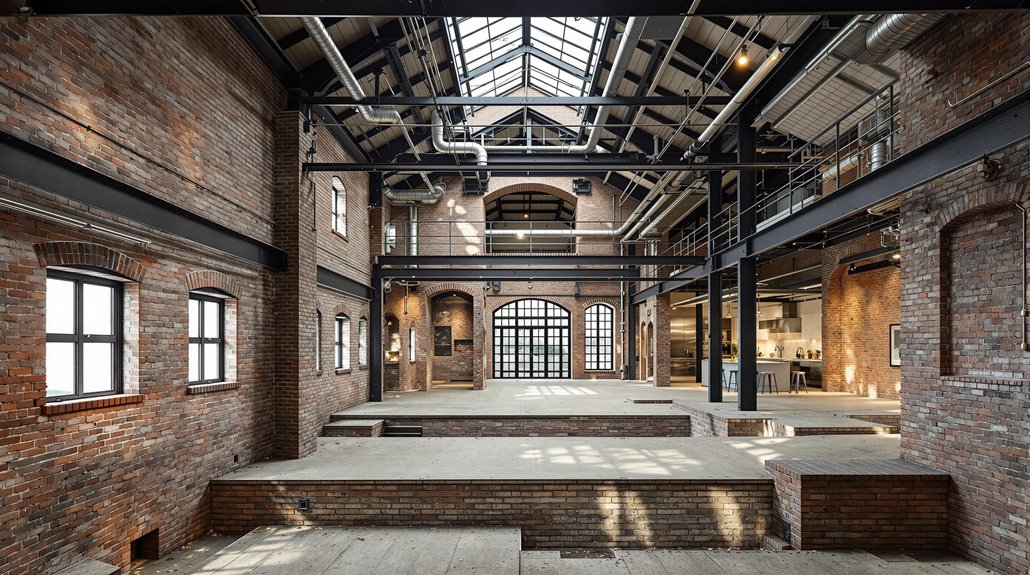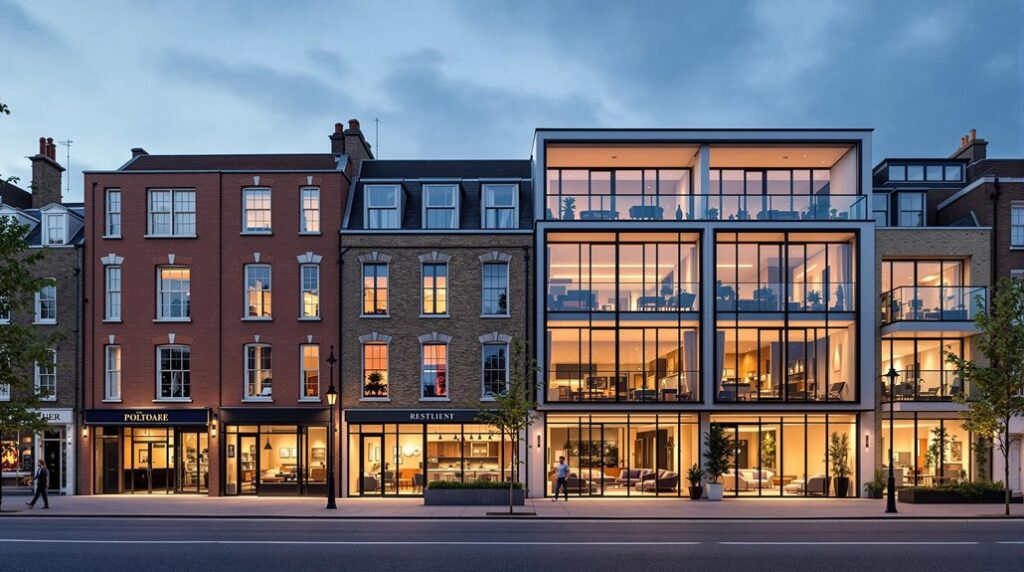I’ve been tracking the surge in commercial-to-residential conversions across the UK, and the numbers tell a compelling story. You’re looking at a market where office blocks become apartment complexes in months rather than years, yet I’m seeing developers hit unexpected walls that can sink entire projects. The financial rewards are substantial when you get it right, but there’s a maze of regulatory pitfalls that most people don’t anticipate until it’s too late.
Key Takeaways
- Converting commercial properties to residential delivers homes 40% faster than traditional builds and cuts development costs by 30%.
- Government incentives include grants up to £10,000 per apartment, tax breaks, and permitted development rights that often bypass full planning permission.
- Regulatory challenges include Use Class eligibility requirements, Article 4 direction restrictions, and mandatory EPC rating of C for residential properties.
- Structural complications arise from hidden defects, load-bearing modifications, fire safety upgrades, and costly electrical and plumbing system overhauls.
- Market saturation with 89,500+ conversions since 2015 increases competition, while lenders view conversions as higher-risk investments requiring substantial contingency funds.
The Growing Trend of Commercial-to-Residential Conversions

As hybrid work models reshape our commercial landscape, property developers and investors are capitalizing on a striking opportunity: converting underutilized office buildings and retail spaces into desperately needed residential units. I’ve watched this trend accelerate dramatically, with commercial-to-residential applications jumping 63% between 2021 and 2023.
The numbers tell a compelling story. Since 2015, we’ve created nearly 96,000 new homes through office conversions alone. This year, I’m seeing a 26% increase in applications compared to last year, with projections showing 20% growth by 2025. The current trends in the UK housing market indicate that demand for housing continues to rise, further fueling this conversion boom.
What’s driving this surge? Commercial property values have plummeted up to 15% in secondary markets, while housing demand remains intense. The government’s relaxed Permitted Development Rights have removed previous barriers, eliminating size caps and streamlining approval processes for savvy developers. These conversions offer higher profit potential by allowing investors to acquire low-cost commercial properties and transform them into valuable residential assets.
How Conversions Help Tackle the UK Housing Crisis
The surge in conversion applications reflects a deeper reality: these projects directly address the UK’s acute housing shortage in ways that new construction simply can’t match. I’ve seen conversions deliver homes 40% faster than traditional builds, adding over 10,000 units annually to our housing stock. In many cases, these conversions also feature modern design elements, which enhance the overall appeal of the living spaces.
You’re not just creating shelter – you’re solving multiple crises simultaneously. Each converted building reduces homelessness by transforming derelict spaces into affordable homes. I’ve watched conversions cut development costs by 30%, making homeownership accessible for first-time buyers previously priced out. Moreover, by improving energy efficiency, these renovations contribute to a more sustainable future.
These projects tackle inequality head-on. You’re bringing affordable housing to high-demand areas where land’s scarce, supporting key workers like nurses and teachers. When you convert commercial properties, you’re revitalizing struggling communities while preserving our urban infrastructure – that’s strategic problem-solving at its finest. Official housing statistics are released every six months, providing crucial data to track the effectiveness of these conversion initiatives across England.
Financial Benefits and Streamlined Planning Processes

When you’re weighing conversion projects against traditional development, the financial advantages become immediately clear. You’ll find substantial grant support available—Cheshire West & Chester Council provides up to £10,000 per apartment created, with project caps reaching £50,000. Government tax breaks further sweeten these deals for developers like us. In addition to these incentives, understanding local market dynamics can significantly influence the success of your investment.
The planning process has been revolutionized. Permitted development rights mean you’ll often skip full planning permission entirely, thanks to 2021 amendments that eased commercial repurposing. This cuts both time and administrative costs considerably.
Your funding options are robust too. Development finance and bridging loans specifically target conversion projects. Since retrofitting reduces new construction needs, you’re looking at lower overall costs while transforming underutilized assets into high-yielding residential investments that revitalize neighborhoods. Additionally, projects located within Enterprise Zones can benefit from business rate discounts of up to 100% over five years, significantly reducing operational costs.
Regulatory Hurdles and Planning Complexities
Despite these financial incentives, you’ll encounter significant regulatory obstacles that can derail even well-funded conversion projects. I’ve seen developers stumble when they misinterpret Use Class eligibility—confusing Class E with other categories invalidates your permitted development rights entirely. You’ll need prior approval from local councils, but here’s where it gets tricky: processing times vary wildly from 8 weeks to 6+ months depending on your council’s resources.
The 2024 amendments removed the 3-month vacancy requirement, yet rapid policy shifts create compliance ambiguity that’ll keep you guessing. Each council imposes different conditions for noise mitigation and parking requirements. Local authorities can implement Article 4 directions to restrict permitted development rights in specific areas, requiring full planning permission instead. Understanding the legal requirements for conversions is crucial to avoid delays or enforcement actions. Pre-application advice fees range from £300 to £1,500, adding unpredictable costs to your budget. Unauthorized conversions trigger unlimited fines and enforcement notices—compliance isn’t optional.
Structural Constraints and Design Challenges

Beyond regulatory headaches, you’ll face equally challenging physical realities when converting commercial spaces into homes. I’ve seen countless projects where structural surveys reveal hidden defects—from asbestos to inadequate insulation—that weren’t apparent initially. You’ll need to reinforce load-bearing elements since commercial buildings handle different weight distributions than residential properties.
The real design challenge comes with creating livable spaces from open-plan layouts. You’ll struggle with natural light distribution, ventilation flow, and overheating risks that commercial designs never considered. Fire safety modifications become complex structural undertakings, requiring new exits and sprinkler systems that may demand significant alterations. Office buildings often feature single staircases that fail to meet residential evacuation requirements, necessitating costly structural modifications.
Service upgrades present another hurdle—commercial electrical and plumbing systems rarely translate effectively to residential needs, often requiring complete overhauls that impact your timeline and budget.
Economic Risks and Market Feasibility Concerns
While structural challenges complicate conversions, the financial realities often determine whether your project succeeds or fails. I’ve seen countless developers underestimate the true costs involved in these transformations.
Your biggest risk lies in cost overruns. Most conversions exceed initial budgets by 20-30% due to unforeseen structural issues, updated building codes, and the complexity of making commercial spaces livable. You’ll need substantial contingency funds. Additionally, understanding the typical costs associated with selling a house in Scotland, such as estate agent commissions, can help you plan more effectively.
Market saturation presents another concern. With over 89,500 conversions completed since 2015 and applications rising 20% annually, competition intensifies. You must thoroughly research local demand before committing.
Financing proves challenging too. Lenders view conversions as higher-risk investments, often requiring extensive feasibility studies and charging premium rates. Factor in regulatory compliance costs, professional fees, and long-term climate adaptation requirements for realistic budgeting. Remember that converted residential properties must achieve a minimum EPC rating of C to avoid fines and letting difficulties.
Conclusion
Converting commercial properties to residential use offers real opportunities to tackle housing shortages while potentially reducing your development costs and timelines. However, you’ll need to navigate regulatory complexities, assess structural limitations, and carefully evaluate market demand. I’d recommend conducting thorough due diligence on planning requirements, building surveys, and local housing needs before committing. Success depends on balancing the streamlined processes with hidden risks through proper research and realistic budgeting.
References
- https://brickflow.com/brickflow-thinks/commercial-to-residential-conversion
- https://searchland.co.uk/blog/converting-commercial-to-residential-property
- https://www.planningresource.co.uk/article/1916387/why-commercial-to-residential-permitted-development-applications-hit-record-high
- https://www.alanboswell.com/resources/commercial-property-statistics/
- https://www.buyassociationgroup.com/en-us/news/demand-residential-property/
- https://www.gov.uk/government/collections/housing-statistics
- https://www.understandingsociety.ac.uk/news/2025/02/26/understanding-society-research-housing-crisis/
- https://www.ons.gov.uk/peoplepopulationandcommunity/housing
- https://www.youtube.com/watch?v=Ca8BbPwKuiY
- https://www.gov.uk/government/news/uk-house-price-index-for-april-2025

